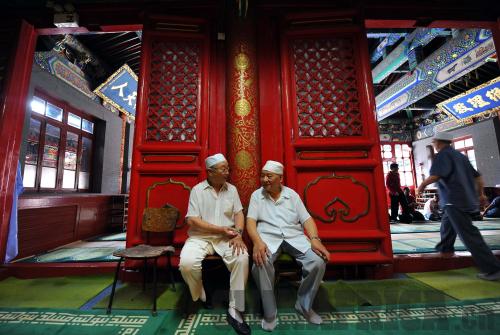| 
Niujie, or Ox Street, is situated in the southwest of Beijing's Xicheng District. The avenue is best known for Niujie Mosque, the city's oldest and largest mosque, catering to both tourists and the Muslim population living in its vicinity.
The mosque was first built in 996 by an imam named Nasruddin, the son of an Arab imam who came to China to preach the Islamic faith. It was rebuilt in 1442 during the Ming Dynasty (1368-1644), and expanded in 1696 in the Qing Dynasty (1644-1911). Covering an area of over 6,000 square meters, the mosque consists of several buildings, namely the Prayer Hall, the Calling Tower, the Moon-Watching Tower, and two pavilions with stone steles.
Since the founding of the People's Republic of China in 1949, three major renovation projects on the mosque have been carried out, its structure redecorated and repainted. The mosque now is a blend of Islamic and Chinese imperial architectural styles. Its interior halls are full of Islamic decorations.
The most important place in Niujie Mosque is the 600-square-meter Prayer Hall, which can hold over 1,000 worshippers. Non-Muslim visitors cannot enter the Prayer Hall, but are able to view the hall from the outside. In the middle of the mosque's courtyard stands a two-story tower. Originally built as a script depository, it was later used by imams as a place from which they called Muslims to prayer – thus it was named the Calling Tower.
When visiting the mosque, proper dress is required. Visitors will not be allowed to enter if they are wearing shorts or short skirts. Over the years, the mosque has greeted Muslims from all over the world to worship, and the Ox Street area has attracted a significant Muslim community to settle around it.
Back in the 17th century, Ox Street was already an important market spot for halal beef and mutton. Today, the Muslim atmosphere still remains quite strong. Visitors can peruse many stores and restaurants featuring Arabic style and Islamic art.
Because the Niujie neighborhood is home to the largest Muslim community in Beijing, a rich Muslim culture cultivating a distinguished cuisine has taken hold in the area. For hundreds of years, Muslim cuisine has blended with local Beijing-style cooking to create a unique culinary art. It's the best place to enjoy authentic local Muslim food in the city.
There are all kinds of Muslim snack shops and big restaurants along the street and Niujie's surrounding hutongs. The selection is huge – everything from stir-fried tofu, fried bagels, pancakes, sticky rice with sweet fillings, fried flour strips, roasted lamb kebabs, and braised mutton. These Muslim eateries are also popular with non-Muslims.
To experience Islamic culture in China's capital, Ox Street should rank highly in any visitors' itinerary.
Hutong Tips
How to get there
> By subway: Take Subway Line 2 to Changchunjie Station, or Subway Line 4 to Caishikou Station, the street is a 20-minute walk from the stop
> By bus: Take bus10/48/ 88/ 213/717 to Niujie Libaisi Station
What to buy
> Beijing Niujie Muslim Supermarket is the biggest food and commodity store catering to Muslims in China today. The 60-odd stalls there sell all kinds of Muslim delicacies.
> Address: No. 5 Niujie Street
What to eat
> Hongshunxuan Restaurant serves delicious Muslim dishes, like roasted lamb kebabs and ox tail. It has nice environment, nice service, and is also not too expensive. Jubaoyuan Restaurant, a time-honored Muslim hot pot place, is known for its fresh beef and mutton selection. |